Feel the Love: How to Talk to My Child about Therapy

We all go through phases and life seasons where we need extra help and support. But asking for help…especially for many of us stubborn adults (myself included)… can be difficult. Often times the biggest hurdles are the initial ones. Acknowledging the need for help, and taking the first few steps to seek out and initiate asking for help can be the hardest.
As parents or caregivers, it can be a little bit easier to ask for help for those that we love and care for, because we feel a sense of responsibility to advocate for their needs. And it is a BIG, and important responsibility to advocate for our loved ones. But that doesn’t mean it is easy to ask for help for our loved ones. Or that we know how to navigate the way to getting them the help they might need. In addition, it certainly doesn’t mean they understand, or will be willing or able to accept help just because we have advocated for their needs. And more often than not…Asking for help for a child, simultaneously means asking for help for yourself and your family.
There are all sorts of tricky emotions, perceptions, stigmas, and unknowns that become barriers to seeking and finding the help that your child, you or your family might need during a difficult phase or life season. There are often stigmas about seeking professional help. There are financial considerations that can make accessing the right help difficult, particularly if insurance doesn’t cover or offset the cost of care and a family doesn’t have the resources to pay privately. And when children and families are in the midst of a difficult life season, dealing with challenges they often don’t fully understand, finding the right help for certain needs and issues can seem full of overwhelming uncertainties.
Asking for help can feel uncomfortable…It can feel scary…It can feel heavvvy.
But it can also feel like a lifeline. It can feel like relief. It can feel like a much needed embrace in the midst of a life challenge. And it can lead to such positive outcomes for children and their families.
So whether you, your child, or your family might need professional help for a difficult phase or life season OR just need some tangible ideas that promote a home environment of love, support and acceptance…Let’s explore some strategies that help us talk to children about therapy.
Acknowledge a Need for Help
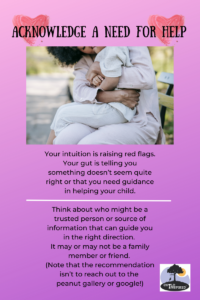
Your intuition is raising red flags. Your gut is telling you something doesn’t seem quite right or that you need guidance in helping your child.
Maybe there is a developmental concern about your child’s skills and abilities? Maybe your child is demonstrating behaviors that have become more intense or disruptive? Maybe your child or family is trying to manage lots of BIG feelings? Maybe your child or family is struggling to cope with the loss of a loved one? Maybe there has been a recent life change that is impacting healthy interactions and relationships?
Whatever the concern…trust your intuition. Think about who might be a trusted person or source of information that can guide you in the right direction. It may or may not be a family member or friend. (Note that the recommendation isn’t to reach out to the peanut gallery or google!) It might be your child’s pediatrician, maybe the director of a childcare or preschool program, a trusted educator or therapist in your neighborhood or community. Reach out and inquire about what resources they might recommend you connect with to address your concern.
Label Emotions
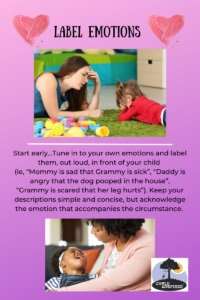 To promote language development, Early Childhood Educators, Speech and Occupational Therapists recommend labeling objects and actions throughout a child’s daily routine. To put it simply…Narrate day-to-day observations out loud. Talk to your babies and toddlers (ie, “Mommy is cooking”, “Wow! A big truck!”, “Yummy, applesauce”). When they make an effort to communicate back to you with a coo, babble or word, acknowledge them with a wide smile and excitement!!!
To promote language development, Early Childhood Educators, Speech and Occupational Therapists recommend labeling objects and actions throughout a child’s daily routine. To put it simply…Narrate day-to-day observations out loud. Talk to your babies and toddlers (ie, “Mommy is cooking”, “Wow! A big truck!”, “Yummy, applesauce”). When they make an effort to communicate back to you with a coo, babble or word, acknowledge them with a wide smile and excitement!!!
Children will be closely observing their parents and caregivers (even when you might think they aren’t). Now while we might try to give our children “our best selves” and try not to show our sadness, frustration, or worry in front of them…the adults in their lives are human too! “Hiding” our feelings from our children doesn’t really do them any long-term favors, as it doesn’t help them learn how to manage those bigger emotions that (whether we like it or not) they will experience in life. So start early…Tune in to your own emotions and label them, out loud, in front of your child (ie, “Mommy is sad that Grammy is sick”, “Daddy is angry that the dog pooped in the house”, “Grammy is scared that her leg hurts”). Keep your descriptions simple and concise, but acknowledge the emotion that accompanies the circumstance. When your child becomes upset, use the same method and model labelling their emotions (ie, “I see you are mad that your train is broken”, “I see you are sad that you scraped your knee”, “I see that you are worried about the dark”).
Practice labeling emotions with these Dealing with Feelings visual supports. For children 2-4 years old, make it fun by hiding a few of these cards around the family room, dimming the lights, grabbing a flashlight, and going on a “feelings hunt”. For children 4-8, using an emotion card set like Dealing with Feelings that has 2 of each card makes for a fun, adapted game of Memory or Go Fish. An emotion card set that includes body sensations (ie, fever, headache, tummy ache) is also great to help children improve body awareness and the accompanying language to communicate their physiological state and experiences with others.
Note: It is developmentally-appropriate for toddlers to have tantrums, as they don’t yet have the ability to manage those BIG feelings when they arise. Labeling emotions is an important 1st step in modeling a healthy way to identify feelings and sets the stage for communicating a need for help. (A therapist can help assess if tantrums are becoming a concern-typically based on how frequently they occur, how long they last, and how intense they are).
Model a Helpful Household
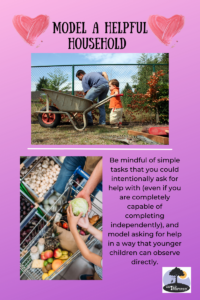
Helping others (and receiving help) can feel good and promote an attitude of appreciation in a home. Model asking for help in your home environment.
Instead of: “Let’s go pick up the soccer balls in the yard”
Try: ”Daddy is cutting the grass and needs our help. Let’s go pick up the soccer balls in the yard”.
Be mindful of simple tasks that you could intentionally ask for help with (even if you are completely capable of completing independently), and model asking for help in a way that younger children can observe directly. Communicate your intentions & elicit the buy-in and help of your partner, another supportive adult, or older child.
Instead of: “Can you stir the sauce into the pasta?”
Try: “I need help. Can you stir the sauce into the pasta?”
Be sure to thank them after completion. “Thank you for helping to pick up the soccer balls. You were a great helper!”
Demystify “Therapy”
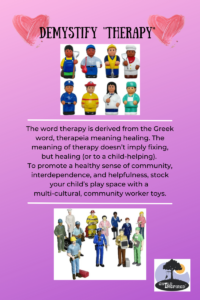 So when an appliance breaks or you have car trouble, we seek the expertise of professionals that know how to help (we hope!). Our sense of community is often formed early in childhood around the idea that different members of our communities have their different skills and talents. The butcher, the baker, the candlestick maker!
So when an appliance breaks or you have car trouble, we seek the expertise of professionals that know how to help (we hope!). Our sense of community is often formed early in childhood around the idea that different members of our communities have their different skills and talents. The butcher, the baker, the candlestick maker!
But yet, our society has become increasingly more obsessed with glorifying self-sufficiency and independence, with a (mis)perception that requesting help implies weakness or insufficiency. To the contrary, requesting help requires self-reflection, self-awareness, and self-acceptance. All things that require strength and appreciation of the value of interdependence.
The word therapy is derived from the Greek word, therapeia, meaning healing. I LOVE that the meaning of therapy doesn’t imply fixing, but healing (or to a child-helping). To promote a healthy sense of community, interdependence, and helpfulness, stock your child’s play space with a multi-cultural, community worker toys:
For children 2-4 years old: Hand held characters are safe and perfect for small hands.
For children 4-8 years old: Characters with additional detail are fun and engaging.
Get on the floor with your children and model different play themes where these workers are helping others. Role-play with these hand-held characters. Create problems, label emotions, pretend the characters request help, and then other characters offer help to find solutions. A therapist is really just another professional helper that (depending on speciality) might support healing of the body, mind, or spirit (emotional wellness).Kids connect with pretend play, so use their toys to model a healthy sense of community support and wellness.
Communicate about Therapy
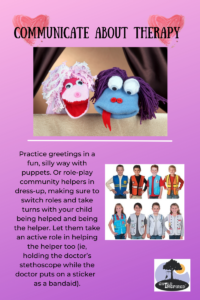
So if you decided its time to consult with a professional to help your child and family, and you have reached out and set up an appointment with a provider…Now What???
Some children are so young, or developmentally unaware of the role of the therapist, so little explanation is necessary. The therapist might easily develop a connection with the child and family because of their child- and family-centered approach, and use of play activities to develop a comfortable rapport.
But for older or inquisitive children, families will often ask, “How am I supposed to explain who you are?” The different needs, age, and developmental level of the child often guides how that is explained. For children ages 3-6 years old, it is helpful to explain that, “A therapist is like a teacher”…And then explain what they might help with. Most children at this age have had an initial experience in a learning environment, and have a connection with a trusted adult in a teacher’s role.
For a child that might need to see a Physical Therapist to address their coordination skills, explain: “A therapist is like a teacher. He/she is going to help your legs get stronger”.
For a child that might need to see a Speech Therapist to address their language skills, explain: “A therapist is like a teacher. He/she is going to help you have more words when we play together”.
For a child that might need to see a Occupational Therapist to address sensory processing skills, explain: “A therapist is like a teacher. “He/she is going to help us find ways to calm our bodies before bedtime”.
For a child that might need to see a Behavior or Mental Health Therapist to address anxiety or emotional regulation, explain: “A therapist is like a teacher. “He/she is going to help us learn what to do when we have BIG feelings”.
For a child that is struggling with anxiety, my absolute favorite is from a dear friend and fellow Occupational Therapist, who explained to her young son that needed to see a psychologist: “Ms.____ is a mystery helper. She helps us figure out our worries and our mysteries.” Her son is a very inquisitive little guy, and there was no negative perception with his trips to see the psychologist. He felt intrigued to help her discover the worries and mysteries, and then empowered to use strategies to better manage them.
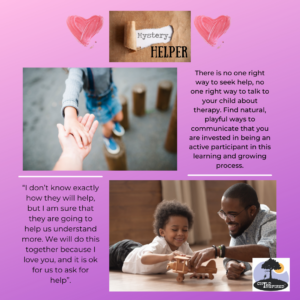 Invest in a couple great puppets (pick animals or characters that resonate with your child). Or consider community helper dress-up clothes for role-play activities with your child. Make it fun!!! Make it silly! Meeting a therapist can be intimidating for parents/families, and (at times) a little anxiety provoking for children. So practice greetings in a fun, silly way with puppets. Role-play community helpers in dress-up, making sure to switch roles and take turns with your child being helped and being the helper. Let them take an active role in helping the helper too (ie, holding the doctor’s stethoscope while the doctor puts on a sticker as a bandaid). Create problems, label emotions, pretend the characters request help, and then other characters offer help to find solutions.
Invest in a couple great puppets (pick animals or characters that resonate with your child). Or consider community helper dress-up clothes for role-play activities with your child. Make it fun!!! Make it silly! Meeting a therapist can be intimidating for parents/families, and (at times) a little anxiety provoking for children. So practice greetings in a fun, silly way with puppets. Role-play community helpers in dress-up, making sure to switch roles and take turns with your child being helped and being the helper. Let them take an active role in helping the helper too (ie, holding the doctor’s stethoscope while the doctor puts on a sticker as a bandaid). Create problems, label emotions, pretend the characters request help, and then other characters offer help to find solutions.
For children over 6 years old, you can use the same prompt to explain the role of a therapist, but possibly include more details on what they might be working on. Or not. Honor your own comfort level. If you don’t feel comfortable, label your experience with, “I don’t know exactly how they will help, but I am sure that they are going to help us understand more. We will do this together because I love you, and it is ok for us to ask for help”.
Most importantly, despite the specific words that might be used in these interactions with your child, it is important to convey an attitude that this is a shared experience with your child. There is no one-right-way to seek help, no one-right-way to talk to your child about therapy. Find natural, playful ways to communicate that you are invested in being an active participant in this learning and growing process. And keep in mind that positive outcomes aren’t necessarily with families that know the most, but with families who commit themselves to actively, engaging in the healing process. Because the foundation for effective helping and healing is LOVE.
Christina Connors, OTR/L has 20 years of experience working as an Occupational Therapist with children and adults throughout Maryland and Delaware. Inspired by her son’s medical journey, and her desire to ease anxiety and improve developmentally-appropriate communication for children and families facing various challenges, Christina founded Child Inspired, which is an emerging family-centered, pediatric wellness practice in Southern Delaware . Christina is so proud of the inspiring group of pediatric therapists that are working collaboratively to bring help and healing to children and families with in-home, outpatient therapy services. The Child Inspired team takes their work very seriously, but does make sure to sprinkle in moments of silliness and laughter, as we all need strategies to cope with the challenges we are often helping others navigate.
Thanks for being part of our village! We’d love to hear from you!

